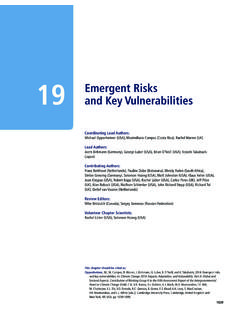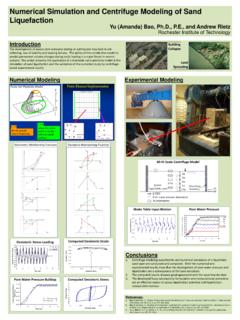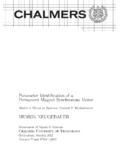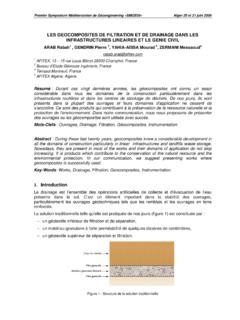Transcription of On the use of the Hardening Soil Small Strain …
1 On the use of the Hardening soil Small Strain model in geotechnical practice Rafa F. Obrzud GeoMod Consulting Eng. Keywords: Deep excavation, retaining wall, tunnel excavation, advanced soil model Abstract This article highlights the importance of using advanced constitutive soil models in numerical modelling as daily geotechnical practice. In this context, the Hardening soil (HS) model is presented as the most advanced soil model implemented in the ZSoil finite element code. The article recalls the basic features of the HS model and it explains their role in numerical simulations. The role of pre-failure non-linear behaviour of soils is also discussed. An application of the HS model is illustrated on typical geotechnical problems such as retaining wall excavation, tunnel excavation and undrained loading followed by consolidation.
2 1. Introduction The use of the finite element (FE) analysis has become widespread and popular in geotechnical practice as means of controlling and optimizing engineering tasks. However, the quality of any stress- Strain prediction depends on the adequate model being adopted in the study. In general, a more realistic prediction of ground movements requires using the models which account for pre-failure behaviour of soil , a non-linear stress- Strain relationship before reaching the ultimate state (cf. [1]). Such behaviour, mathematically modelled with non-linear elasticity, is characterized by a strong variation of soil stiffness which depends on the magnitude of Strain levels occurring during construction stages. Pre-failure stiffness plays a crucial role in modelling typical geotechnical problems such as deep excavations supported by retaining walls or tunnel excavations in densely built-up urban areas.
3 It is commonly known that soil behaviour is not as simple as its prediction with simply-formulated linear constitutive models, which are commonly and carelessly used in numerical analyses. Complex soil behaviour which stems from the nature of the multi-phase material exhibits both elastic and plastic non-linearities. Deformations include irreversible plastic strains. Depending on the history of loading, soil may compact or dilate, its stiffness may depend on the magnitude of stress levels, soil deformations are time-dependent, etc. In fact, soil behaviour is considered to be truly elastic in the range of Small strains as schematically presented in Figure 1. In this range of Strain , soil may exhibit a nonlinear stress- Strain relationship. However, its stiffness is almost fully recoverable in unloading conditions.
4 Following of pre-failure non-linearities of soil behaviour, one may observe a strong variation of stiffness starting from very Small shear strains, which cannot be reproduced by models such as the linear-elastic Mohr-Coulomb model . Engineers who are looking for reliable and realistic predictions of the engineering system response should be aware that by applying linear-elastic, perfectly plastic models in the FE analysis, soil ground movements may be underestimated, which may influence the magnitude of forces which are computed for supporting structural elements. The models which account for high stiffness at very Small strains concentrate the development of high amplitudes of Strain around the close neighbourhood of the source of deformations, similarly to what is observed in reality.
5 This can be the case of retaining walls or tunnel excavations where soil stiffness degrades increasing soil deformations in the close vicinity of unloaded boundaries, and appropriately reducing them away from the unloaded zone (cf. [2]). Figure 1 Typical representation of stiffness variation in as a function of the shear Strain amplitudes; comparison with the ranges for typical geotechnical problems and different tests (based on [1] and updated by the author); SCPT - seismic cone penetration test; CPTU - piezocone penetration test; DMT - Marchetti s dilatometer test; PMT - Pressuremeter test. The Hardening soil (HS) model in its two variants HS-Standard and HS-SmallStrain can be a solution for modelling of the problems which have been listed above, as they account for most of soil behaviour features (see Section 3).
6 Despite the mathematical complexity of the HS model , its parameters have explicit physical meaning and can be determined with conventional soil tests [3]. The present article presents a few examples of the application of this constitutive model for typical geotechnical problems. 2. Choice of the constitutive model The finite element code ZSoil includes a variety of soil models from simple linear elastic, perfectly plastic ( Mohr Coulomb), elasto-plastic cap models ( Cap, Modified Cam Clay) to advanced nonlinear-elasto-plastic cap model HS-SmallStrain. The choice of a constitutive model depends on many factors but, in general, it is related to the type of analysis that the user intends to perform, expected precision of predictions and available knowledge of soil . As regards the type of analysis, geoengineering computings can be divided into two groups (see Figure 2): (a) those whose goal is to assess bearing capacity and slope or wall stability which are related to the ultimate limit state analysis (ULS), and (b) those which are related to the limit state analysis (SLS), such as deep excavations or tunnel excavations in urban areas.
7 In general, as long as assessment of ULS for bearing capacity or slope stability is foreseen, the analysis may be limited to basic linear models such as the Mohr-Coulomb model (but this is not a rule). On the other hand, a precise deformation analysis requires the application of advanced constitutive models which approximate the stress- Strain relation more accurately than simple linear-elastic, perfectly plastic model , and in effect, the form of displacement fields can be modelled more realistically. GEOENGINEERING COMPUTINGSLIMIT STATE ANALYSISDEFORMATION ANALYSISB earing capacitySlope, wall stabilityPile, retaining wall deflectionSupported deep excavationsTunnel excavationsConsolidation problems including ground water loweringTypically used models:Basic linear models Mohr-CoulombRecommended models:Advanced non-linear constitutive models Hardening - soil Figure 2 General types of geoengineering computings.
8 The Hardening - soil model realistically reproduces soil deformations, as the - relation is approximated with a non-linear curve (the hyperbolic function by Duncan-Chang, for details see [7],[3]). Moreover, as the formulation of the HS model incorporates two Hardening mechanisms, it is suitable for modelling both domination of shear plastic strains which can be observed in granular soils and in overconsolidated cohesive soils, as well as domination of compressive plastic strains which is typical for soft soils, see Figure 3. SANDSCLAYSD egree ofOverconsolidationNormal,Soft claysSILTSD ilatant,Low compressibleNon-dilatant,CompressibleSel ectedsoil modelsimplemented in Z_SoilMohr-Coulomb (Drucker-Prager)CAPM odified Cam-ClayHS-StandardHS- Small StrainHS- Small StrainHS-StdHighStiff claysLowType ofanalysisSLSULSSLSULSSLSULSSLSULS Figure 3 Recommendations for the model choice for soil type and types of analysis.
9 Dashed line: may be used but not recommended in terms of quality of results; Solid line: can be applied; Green fill: recommended. 3. A short overview of the Hardening soil model Features of the model The Hardening soil model (HS-Standard) was designed by [2], [5] in order to reproduce basic macroscopic phenomena exhibited by soils such as: densification, a decrease of voids volume in soil due to plastic deformations, stress dependent stiffness, commonly observed phenomena of increasing stiffness modules with increasing confining stress (also related to increasing depth); soil stress history, accounting for preconsolidation effects; plastic yielding, development of irreversible strains with reaching a yield criterion; dilatancy, an occurrence of negative volumetric strains during shearing.
10 Contrary to other models such us the Cap model or the Modified Cam Clay (let alone the Mohr-Coulmb model ), the magnitude of soil deformations can be modelled more accurately by incorporating three different input stiffness parameters which correspond to the triaxial loading stiffness (E50), the triaxial unloading-reloading stiffness (Eur), and the oedometer loading modulus (Eoed). Deviatoric stress q= strain1E0E50 Eur3= const. 3ref111~E01~E01Ei ~E0 Figure 4 Common definitions of different moduli on a typical Strain -stress curve for soil . An enhanced version of the HS-Standard, the Hardening soil Small model (HSSmallStrain) was formulated by Benz [6] in order to handle the commonly observed phenomena of: strong stiffness variation with increasing shear Strain amplitudes in the domain of Small strains (S-shape curve presented in Figure 1); hysteretic, nonlinear elastic stress- Strain relationship which is applicable in the range of Small strains.







